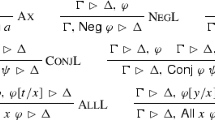Abstract
This paper extends Reiter’s closed world assumption to cases where the assumption is applied in a precedence order between predicates. The extended assumptions are: thepartial closed world assumption, thehierarchical closed world assumption and thestepwise closed world assumption. The paper also defines an extension of Horn formulas and shows several consistency results about the theory obtained from the extended Horn formulas by applying the proposed assumptions. In particular, the paper shows that both the hierarchical closed world assumption and the stepwise closed world assumption characterize the perfect model of stratified programs.
Similar content being viewed by others
Explore related subjects
Discover the latest articles, news and stories from top researchers in related subjects.References
Apt, K. R., Blair, H., and Walker, A., “Towards a Theory of Declarative Knowledge,” inFoundations of Deductive Databases and Logic Programming (J. Minker ed.), Morgan Kaufmann, Los Altos, pp. 89–148, 1988.
Bossu, G. and Siegel, P., “Nonmonotonic Reasoning and Databases,” inAdvances in Database Theory, Vol. 2 (H. Gallaire, J. Minker, and J-M. Nicolas eds.), Plenum Press, New York, pp. 239–284, 1984.
Bossu, G. and Siegel P., “Saturation, Nonmonotonic Reasoning and the Closed World Assumption,”Artificial Intelligence, 25, pp. 13–63, 1985.
Clark, K. L., “Negation as Failure,” inLogic and Data Bases (H. Gallaire and J. Minker, eds.), Plenum Press, New York, pp. 293–322, 1978.
Fagin, R., “Horn Clauses and Database Dependencies,”J. ACM, Vol.29, No. 4, pp. 952–985, Oct. 1982.
Ebbinghaus, H. D., Flum, J., and Thomas, W.,Mathematical Logic, Springer-Verlag, Berlin and New York, 1984.
Gallaire, H., Minker, J., and Nicolas, J-M., “Logic and Databases: A Deductive Approach,”Computing Surveys, Vol. 16, No. 2, pp. 153–185, June 1984.
Gelfond, M. and Przymusinska, H., “Negation as Failure: Careful Closure Procedure,”Artificial Intelligence, 30, pp. 273–287, 1986.
Gelfond, M., Przymusinska, H., and Przymusinski, T., “On the Relationship between Circumscription and Negation as Failure,”Artificial Intelligence, 38, pp. 75–94, 1989.
Keisler, H. J.,Model Theory for Infinitary Logic, North-Holland Publishing Company, Amsterdam, 1971.
Lifschitz, V., “Closed-World Databases and Circumscription,”Artificial Intelligence, 27, pp. 229–235, 1985.
Lifschitz, V., “Computing Circumscription,” inProceedings of IJCAI-85, pp. 229–235, 1985.
Lifschitz, V., “On the Declarative Semantics of Logic Programming with Negation,” inFoundations of Deductive Databases and Logic Programming (J. Minker ed.), Morgan Kaufmann, Los Altos, pp. 177–192, 1988.
Lloyd, J. W.,Foundations of Logic Programming, Second, Extended Edition, Springer-Verlag, Berlin and New York, 1987.
McCarthy, J., “Circumscription—A Form of Circumscription to Formalizing Common-Sense Knowledge,”Artificial Intelligence, 28, pp. 89–116, 1986.
Mendelson, E.,Introduction to Mathematical Logic, 2nd Edition, D. Van Nostrand, New York, 1979.
Minker, J., “On Indefinite Databases and the Closed World Assumption,”Springer-Verlag Lecture Notes in Computer Science, No. 138, Springer-Verlag, Berlin and New York, pp. 292–308, 1982.
Przymusinski, T., “On the Declarative and Procedural Semantics of Stratified Disjunctive Databases,” inFoundations of Deductive Databases and Logic Programming (J. Minker ed.), Morgan Kaufmann, Los Altos, pp. 193–216, 1988.
Reiter, R., “On Closed World Data Bases,” inLogic and Data Bases (H. Gallaire and J. Minker, eds.), Plenum Press, New York, pp. 55–76, 1978.
Reiter, R., “Equality and Domain Closure in First-Order Databases,”J. ACM, Vol. 27, No. 2, pp. 235–249, April 1980.
Reiter, R., “Towards a Logical Reconstruction of Relational Database Theory,” inOn Conceptual Modeling (M. Brodie, J. Mylopoulos, and J. W. Schmidt, eds.), Springer-Verlag, Berlin and New York, pp. 191–238, 1984.
Shoenfield, J. R.,Mathematical Logic, Addison-Wesley Publishing Company, Massachusetts, 1967.
Shepherdson, J. C., “Negation as Failure: A Comparison of Clark’s Completed Data Base and Reiter’s Closed World Assumption,”J. Logic Programming, Vol. 1, No. 1, pp. 51–79, 1984.
Yahya, A. and Henschen, L., “Deduction in Non-Horn Databases,”J. Autom. Reasoning, Vol. 1 No. 2, pp. 141–160, 1985.
Van Gelder, A., “Negation as Failure Using Tight Derivations for General Logic Programming,”Third IEEE Symposium of Logic Programming, pp. 127–138, 1986.
Author information
Authors and Affiliations
About this article
Cite this article
Katsuno, H. Closed world assumptions having precedence in predicates. New Gener Comput 8, 185–209 (1990). https://doi.org/10.1007/BF03037516
Received:
Revised:
Issue Date:
DOI: https://doi.org/10.1007/BF03037516




